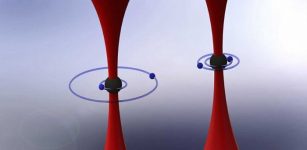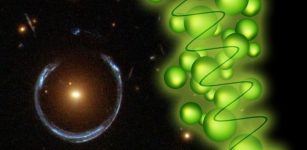Stephen Hawking’s Famous Black Hole Paradox Solved After Hair-Raising Discovery
Eddie Gonzales Jr. – MessageToEagle.com – An international quartet of physicists, including a University of Sussex professor and research student, have co-authored two papers that significantly alter our understanding of black holes and resolve a problem that has confounded scientists for nearly half a century.
Black Hole. Image credit: geralt / – Pixabay
In the first paper, appearing in the journal Physical Review Letters, Professor Xavier Calmet from the University of Sussex School of Mathematical and Physical Sciences, Professor Roberto Casadio (INFN, University of Bologna), Professor Stephen Hsu (Michigan State University), along with PhD student Folkert Kuipers (University of Sussex), have demonstrated that black holes are more complex than originally understood and have a gravitational field that, at the quantum level, encodes information about how they were formed.
In the 1960’s, eminent physicist, John Archibald Wheeler expressed the fact that black holes are lacking any observable features beyond their total mass, spin and charge with the phrase “black holes have no hair”. This is known as the no-hair theorem. Having demonstrated that black holes do in fact have this additional characteristic, Professor Calmet and his collaborators have labeled their discovery as a ‘quantum hair from gravity’, in a nod to Wheeler’s phrase.
Using specific mathematical methods largely developed at the University of Sussex over the past ten years to perform calculations in quantum gravity, the scientists have shown explicitly that matter that collapses into a black hole leaves an imprint in the gravitational field of the black hole when quantum gravitational corrections are taken into account. This imprint is what the scientists are referring to as a ‘quantum hair’.
Specifically, they compared gravitational fields of two stars with the same total mass and radii but different compositions. At the classical level, the two stars have the same gravitational potential, but at the quantum level, the potential depends on the star composition. When the stars collapse into black holes, their gravitational fields preserve the memory of what the stars were made of and lead to the conclusion that black holes do have hair, after all.
In a follow-up paper, published in a separate journal, Physics Letters B, Prof Calmet and Prof Hsu show that their ‘quantum hair’ resolves Hawking’s Black Hole Information Paradox, which arose from Professor Stephen Hawking’s suggestion in 1976 that, as they evaporate and emit thermal radiation, black holes destroy information about what had formed them. This appeared to violate a fundamental law of quantum mechanics which states that any process in physics can be mathematically reversed.
The scientists’ ‘quantum hair’, however, provides the mechanism by which information is preserved during the collapse of a black hole and as such resolves one of modern science’s most famous quandaries.
The ground-breaking results are the product of a long-term collaboration between Prof Calmet, Prof Casadio and Prof Hsu. They also build on previous discoveries from Prof Calmet to the nature of black holes and quantum gravity, including research published in 2021 that demonstrated, for the first time, that black holes exert a pressure.
Reflecting on the quantum hair’s implications for physics, Xavier Calmet, Professor of Physics at the University of Sussex, said: “Black holes have long been considered the perfect laboratory to study how to merge Einstein’s theory of general relativity with quantum mechanics. It was generally assumed within the scientific community that resolving this paradox would require a huge paradigm shift in physics, forcing the potential reformulation of either quantum mechanics or general relativity.
“What we found – and I think is particularly exciting – is that this isn’t necessary. Our solution doesn’t require any speculative idea, instead our research demonstrates that the two theories can be used to make consistent calculations for black holes and explain how information is stored without the need for radical new physics.
“It turns out that black holes are in fact good children, holding onto the memory of the stars that gave birth to them.”
Explaining the discovery of the quantum hair, Roberto Casadio, Professor of Theoretical Physics from the University of Bologna, said: “A crucial aspect is that black holes are formed by the collapse of compact objects and then, according to the quantum theory, there is no absolute separation between the interior and the exterior of the black hole. In the classical theory, the horizon acts as a perfect one-way membrane that does not let anything out and the exterior is therefore the same for all black holes of a given mass.
This is the classical no-hair theorem.
However, in the quantum theory, the state of the matter that collapses and forms the black hole continues to affect the state of the exterior, albeit in a way that is compatible with present experimental bounds. This is what is known as quantum hair.”
Written by Eddie Gonzales Jr. – MessageToEagle.com Staff











